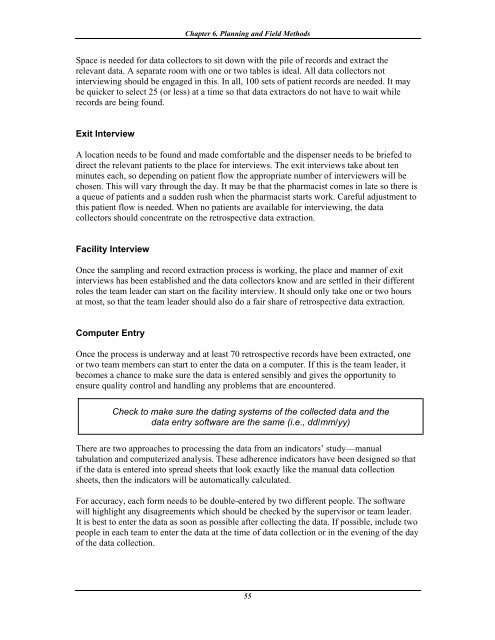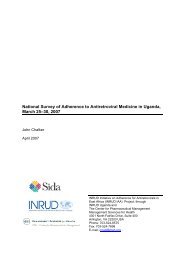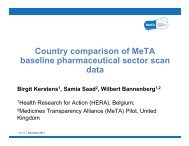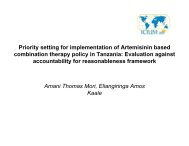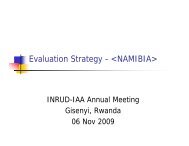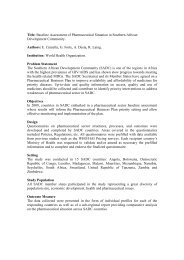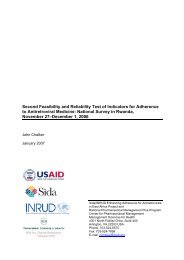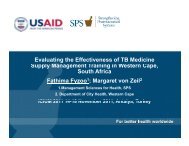How to investigate Adherence to Antiretroviral Treatment ... - INRUD
How to investigate Adherence to Antiretroviral Treatment ... - INRUD
How to investigate Adherence to Antiretroviral Treatment ... - INRUD
Create successful ePaper yourself
Turn your PDF publications into a flip-book with our unique Google optimized e-Paper software.
Chapter 6. Planning and Field Methods<br />
Space is needed for data collec<strong>to</strong>rs <strong>to</strong> sit down with the pile of records and extract the<br />
relevant data. A separate room with one or two tables is ideal. All data collec<strong>to</strong>rs not<br />
interviewing should be engaged in this. In all, 100 sets of patient records are needed. It may<br />
be quicker <strong>to</strong> select 25 (or less) at a time so that data extrac<strong>to</strong>rs do not have <strong>to</strong> wait while<br />
records are being found.<br />
Exit Interview<br />
A location needs <strong>to</strong> be found and made comfortable and the dispenser needs <strong>to</strong> be briefed <strong>to</strong><br />
direct the relevant patients <strong>to</strong> the place for interviews. The exit interviews take about ten<br />
minutes each, so depending on patient flow the appropriate number of interviewers will be<br />
chosen. This will vary through the day. It may be that the pharmacist comes in late so there is<br />
a queue of patients and a sudden rush when the pharmacist starts work. Careful adjustment <strong>to</strong><br />
this patient flow is needed. When no patients are available for interviewing, the data<br />
collec<strong>to</strong>rs should concentrate on the retrospective data extraction.<br />
Facility Interview<br />
Once the sampling and record extraction process is working, the place and manner of exit<br />
interviews has been established and the data collec<strong>to</strong>rs know and are settled in their different<br />
roles the team leader can start on the facility interview. It should only take one or two hours<br />
at most, so that the team leader should also do a fair share of retrospective data extraction.<br />
Computer Entry<br />
Once the process is underway and at least 70 retrospective records have been extracted, one<br />
or two team members can start <strong>to</strong> enter the data on a computer. If this is the team leader, it<br />
becomes a chance <strong>to</strong> make sure the data is entered sensibly and gives the opportunity <strong>to</strong><br />
ensure quality control and handling any problems that are encountered.<br />
Check <strong>to</strong> make sure the dating systems of the collected data and the<br />
data entry software are the same (i.e., dd/mm/yy)<br />
There are two approaches <strong>to</strong> processing the data from an indica<strong>to</strong>rs’ study—manual<br />
tabulation and computerized analysis. These adherence indica<strong>to</strong>rs have been designed so that<br />
if the data is entered in<strong>to</strong> spread sheets that look exactly like the manual data collection<br />
sheets, then the indica<strong>to</strong>rs will be au<strong>to</strong>matically calculated.<br />
For accuracy, each form needs <strong>to</strong> be double-entered by two different people. The software<br />
will highlight any disagreements which should be checked by the supervisor or team leader.<br />
It is best <strong>to</strong> enter the data as soon as possible after collecting the data. If possible, include two<br />
people in each team <strong>to</strong> enter the data at the time of data collection or in the evening of the day<br />
of the data collection.<br />
55


